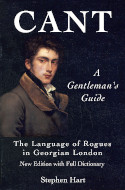THE TRAVELLERS' CLUB
This famous Club was originated shortly after the Peace of 1814, by the Marquis of Londonderry (then Lord Castlereagh), with a view to a resort for gentlemen who had resided or travelled abroad, as well as with a view to the accommodation of foreigners, who, when properly recommended, receive an invitation for the period of their stay. One of the Rules directs "That no person be considered eligible to the Travellers' Club who shall not have travelled out of the British Islands to a distance of at least 500 miles from London in a direct line." Another Rule directs "That no dice and no game of hazard be allowed in the rooms of the Club, nor any higher stake than guinea points, and that no cards be introduced before dinner."
Prince Talleyrand, during his residence in London, generally joined the muster of whist-players at the Travellers'; probably, here was the scene of this felicitous rejoinder. The Prince was enjoying his rubber, when the conversation turned on the recent union of an elderly lady of respectable rank. "How ever could Madame de S—— make such a match?—a person of her birth to marry a valet-de-chambre!" "Ah," replied Talleyrand, "it was late in the game: at nine we don't reckon honours."
The present Travellers' Club-house, which adjoins the Athenæum in Pall-Mall, was designed by Barry, R.A., and built in 1832. It is one of the architect's most admired works. Yet, we have seen it thus treated, with more smartness than judgment, by a critic who is annoyed at its disadvantageous comparison with its more gigantic neighbours:—
"The Travellers' is worse, and looks very like a sandwich at the Swindon station—a small stumpy piece of beef between two huge pieces of bread, i.e. the Athenæum and the Reform Clubs, which look as if they were urging their migratory neighbour to resume the peregrinations for which its members are remarkable. Yet people have their names down ten years at the Travellers' previous to their coming up for ballot. An election reasonably extended would supply funds for a more advantageous and extended position."
The architecture is the nobler Italian, resembling a Roman palace: the plan is a quadrangle, with an open area in the middle, so that all the rooms are well lighted. The Pall-Mall front has a bold and rich cornice, and the windows are decorated with Corinthian pilasters: the garden front varies in the windows, but the Italian taste is preserved throughout, with the most careful finish: the roof is Italian tiles. To be more minute, the consent of all competent judges has assigned a very high rank to this building as a piece of architectural design; for if, in point of mere quantity, it fall greatly short of many contemporary structures, it surpasses nearly every one of them in quality, and in the artist-like treatment. In fact, it makes an epoch in our metropolitan architecture; for before, we had hardly a specimen of that nobler Italian style, which, instead of the flutter and flippery, and the littleness of manner, which pervade most of the productions of the Palladian school, is characterized by breath and that refined simplicity arising from unity of idea and execution, and from every part being consistently worked up, yet kept subservient to one predominating effect. Unfortunately, the south front, which is by far the more striking and graceful composition, is comparatively little seen, being that facing Carlton Gardens, and not to be approached so as to be studied as it deserves; but when examined, it certainly must be allowed to merit all the admiration it has obtained. Though perfect, quiet, and sober in effect, and unostentatious in character, this building of Barry's is remarkable for the careful finish bestowed on every part of it. It is this quality, together with the taste displayed in the design generally, that renders it an architectural bijou. Almost any one must be sensible of this, if he will but be at the pains to compare it with the United Service Club, eastward of which, as far as mere quantity goes, there is much more.
Another critic remarks: "The Travellers' fairly makes an epoch in the architectural history of Club-houses, as being almost the first, if not the very first, attempt, to introduce into this country that species of rich astylar composition which has obtained the name of the Italian palazzo mode, by way of contradistinction from Palladianism and its orders. This production of Barry's has given a fresh impulse to architectural design, and one in a more artistic direction; and the style adopted by the architect has been applied to various other buildings in the provinces as well as in the metropolis; and its influence has manifested itself in the taste of our recent street architecture."
The Travellers' narrowly escaped destruction on October 24, 1850, when a fire did great damage to the billiard-rooms, which were, by the way, an afterthought, and addition to the original building, but by no means an improvement upon the first design, for they greatly impaired the beauty of the garden-front.
John Timbs
Club Life of London Vol. I
London, 1866

